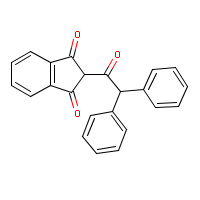Diphacinone
Agent Name
Diphacinone
CAS Number
82-66-6
Formula
C23-H16-O3
Major Category
Pesticides

Synonyms
1,3-Indandione, 2-(diphenylacetyl)- (8CI); 1H-Indene-1,3(2H)-dione, 2-(diphenylacetyl)- (9CI); 2-(Diphenylacetyl)-1,3-indandione; 2-(Diphenylacetyl)-1H-indene-1,3(2H)-dione; 2-Diphenyl-acetyl-indan-1,3-dion [German]; 2-Diphenylacetyl-1,3-diketohydrindene; Contrax-D; Didandin; Didion; Difenadiona [INN-Spanish]; Difenadione [DCIT]; Dipaxin; Diphac; Diphacin; Diphacin [Turkey]; Diphacinone; Diphacins; Diphenacin; Diphenadion; Diphenadione; Diphenadionum [INN-Latin]; Diphenandione; Gold Crest; Kill-Ko Rat Killer; Oragulant; P.C.Q.; PCQ; PID; Parakakes; Promar; Promar PCQ; Ramik; Ratindan; Ratindan 1; Rodent Cake; Solvan; U 1363; U-1363; URI 788; [ChemIDplus] Trade names: Diphacine, Ditrac, Gold Crest, Kill-Ko, P.C.Q., Promar, Ramik, Rat Killer, Rodent Cake, and Tomcat; [Extoxnet]
Category
Rodenticides, Anticoagulant
Description
Odorless, pale yellow powder formulated as meal, pellet, wax block, and liquid bait; [EXTOXNET]
Sources/Uses
Used as a medication, rodenticide, and baticide; [HSDB]
Comments
"This material is extremely toxic; probable oral lethal dose in humans is 5-50 mg/kg, or between 7 drops and 1 teaspoonful for a 150-lb. person." [CAMEO] Oral LD50 (rats) = 0.3-7 mg/kg; Dermal LD50 (rats) = 200 mg/kg; It poisons the synthesis of coagulation proteins and causes death by internal hemorrhaging. [EXTOXNET]
Reference Link #1
Biomedical References
Exposure Assessment
Vapor Pressure
1.03E-10 mm Hg
Lethal Concentration
LC50 (rat) = 2000 mg/m3/4H
Half Life
15-20 days; Rats eliminate 80% of dose within 8 days; [EXTOXNET]
Reference Link #2
Diseases, Processes, and Activities Linked to This Agent
Processes
Industrial Processes with risk of exposure: